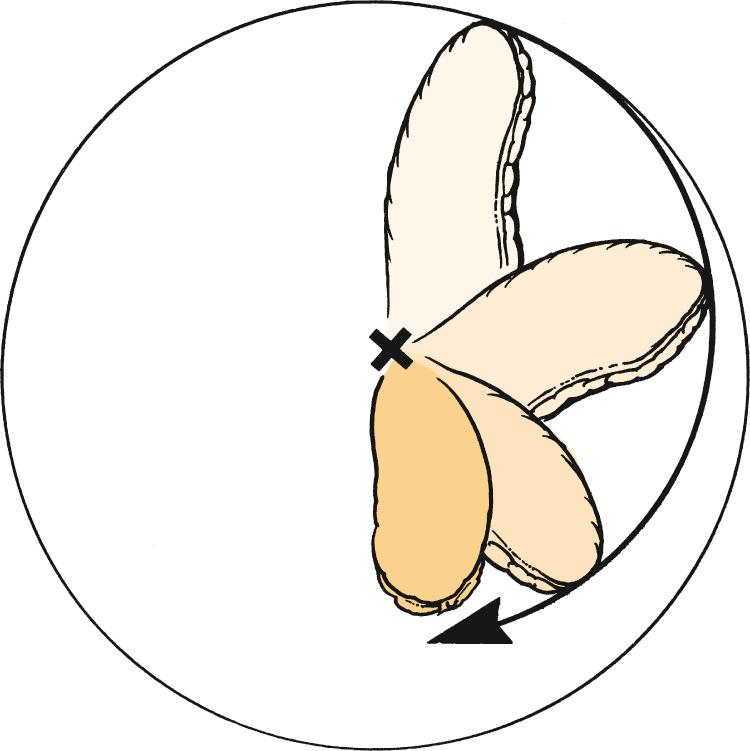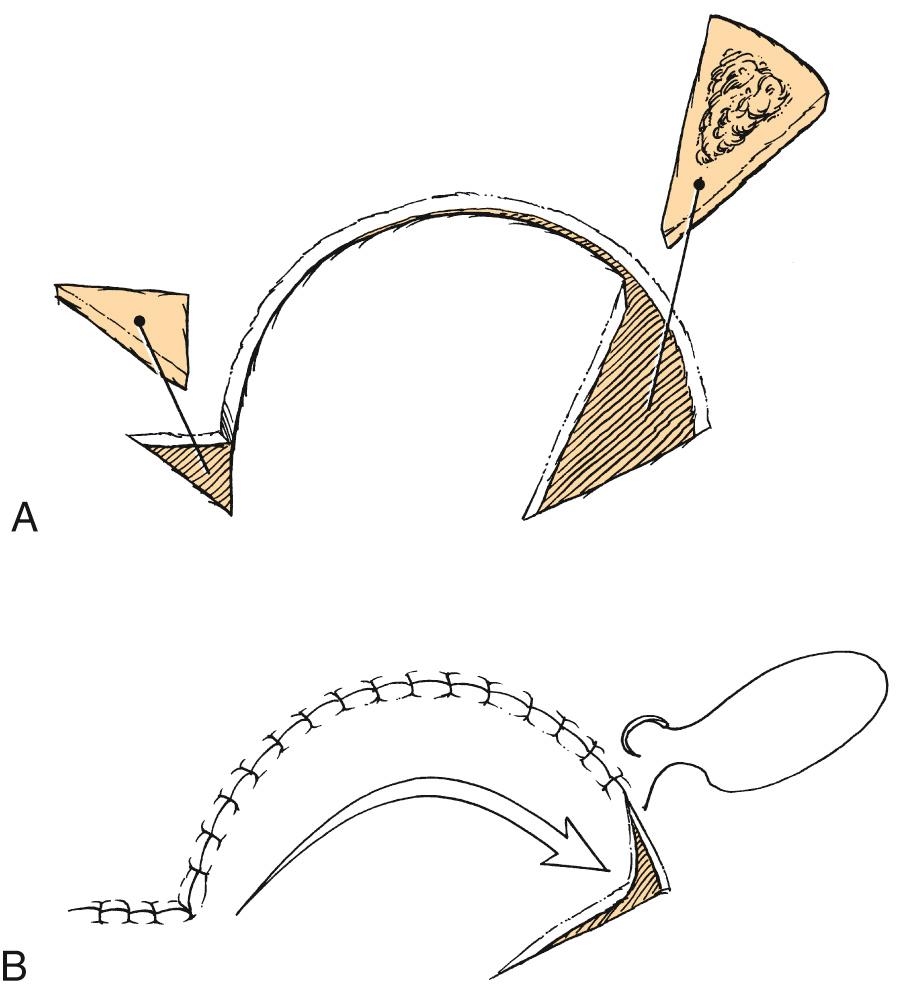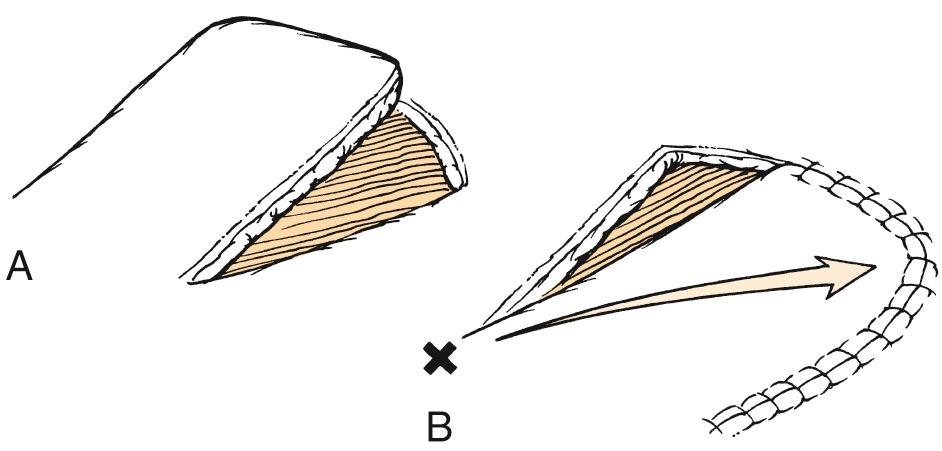Physical Address
304 North Cardinal St.
Dorchester Center, MA 02124
Local flaps may be classified by the method of movement and are referred to as pivotal, advancement, or hinged.
Most flaps are moved by a combination of pivoting and advancement.
Pivotal flaps move toward the defect they are designed to repair by rotating the base of the flap around a pivot point.
Pivotal flaps may be categorized as rotation, transposition, or interpolated.
Advancement flaps move toward the defect they are designed to repair by stretching or recoiling the tissue of the flap.
Advancement flaps may be categorized as unipedicle, bipedicle, V-Y, and Y-V.
Small cutaneous defects of the nose are best repaired with adjacent nasal skin in the form of a local flap.
Cutaneous defects of the nose too large to repair with a local flap are best resurfaced with a full-thickness skin graft for shallow defects and an interpolated paramedian forehead flap or interpolated melolabial flap for deeper defects.
Full-thickness nasal defects require replacement of internal lining, structural support in the form of cartilage or bone grafts, and external cover in the form of an interpolated cheek or forehead flap.
Full-thickness defects of the lip less than one-half the lip width can usually be repaired by primary wound closure or by using local flaps confined to the aesthetic regions of the lips.
Reconstruction of full-thickness defects from one-half to two-thirds the width of the lip often requires composite cross-lip flaps from the opposite lip or from the cheek.
Full-thickness defects greater than two-thirds the width of the lip are best reconstructed by using regional flaps or vascularized microsurgical flaps.
Skin cancer is the most common cancer in humans, and most skin cancers occur on the face. The incidence of squamous cell carcinoma, basal cell carcinoma, and melanoma is increasing, perhaps because of the depletion of the ozone layer or other environmental factors not yet determined. Most cutaneous malignancies are managed surgically, leaving skin defects that require reconstruction. Skin cancers, birth defects, and injuries as a result of trauma and burns require that surgeons be skilled in the repair of facial defects. This chapter addresses the management of many types of facial defects, primarily those resulting from ablation of cutaneous malignancies; however, the principles of local flap design and tissue movement can be readily applied to the reconstruction of all forms of facial defects.
Most facial defects result from ablation of cutaneous malignancies, and most cases can be repaired by primary wound closure or with a local cutaneous or musculocutaneous flap. Because the topic of facial reconstruction is extremely broad and complex, this chapter discusses only local flaps and grafts in the repair of facial cutaneous defects, with the occasional appropriate reference to the repair of skeletal deficiencies. Other publications better address the use of regional flaps in facial reconstruction.
The face can be divided into aesthetic facial regions, which include the forehead, cheeks, eyelids, nose, lips, auricles, and sometimes the scalp. Reconstruction of some of these areas of the face is discussed elsewhere in this text. A multitude of different flaps and grafts can be used to repair a given facial defect; thus several techniques for reconstruction are discussed. The algorithm in Fig. 21.1 displays an approach for analyzing and developing a management plan for surface defects of the face and neck. Selection of a specific flap depends on the location and size of the defect and the intrinsic properties of the flap. Larger defects of the face and neck may be difficult to resurface with local flaps without considerable impairment in form or function. In such circumstances, the surgeon should select a regional flap or skin graft that might be aesthetically less pleasing but that will provide a functional repair. These decisions are determined by clinical judgment. The greater the experience of the surgeon, the better will be the clinical judgment.
Several methods are used to classify cutaneous flaps : (1) by arrangement of their blood supply (e.g., random vs. arterial); (2) by configuration (rhomboid and bilobe); (3) by proximity to the defect (local, regional, and distant); and (4) by the method of transferring the flap. Local cutaneous flaps are designed immediately adjacent to or near the location of the defect. When classified by method of transfer ( Box 21.1 ), local flaps are divided into pivotal, advancement, and hinged categories. A fourth method of tissue movement is microsurgical, but this method does not apply to local flaps. In reality, most local flaps are moved through a combination of pivoting and advancement. For example, most pivotal flaps are aided in tissue movement by using the intrinsic elasticity of the flap through stretching (advancement). Thus surgeons often speak of combined mechanisms of tissue movement, such as a rotation advancement flap. For classification purposes, however, the major mechanism of tissue transfer should dictate the term given to describe a particular flap, unless both mechanisms are of approximately equal importance, in which case the terms describing both mechanisms should be used.
Pivotal flaps
Rotation
Transposition
Interpolated
Advancement flaps
Unipedicle
Bipedicle
V-Y
Y-V
Hinged flap
The three types of pivotal flaps are rotation, transposition, and interpolated (see Box 21.1 ). All pivotal flaps are moved toward the defect by rotating the base of the flap around a pivotal point. Except with island axial flaps—which have been skeletonized to the level of the nutrient vessels—the greater the degree of pivot, the shorter the effective length of the flap ( Fig. 21.2 ). This is because the pivotal point is fixed in position, and the base of the flap is restricted when pivoting around this point because of the development of a standing cutaneous deformity (dog ear). A pivotal flap should be designed to account for this reduction in effective length, which may be as much as 40% with flaps pivoted through an arc of 180 degrees.

Rotation flaps are pivotal flaps that have a curvilinear configuration. They are designed immediately adjacent to the defect and are best used to close triangular defects ( Fig. 21.3 ). Rotation flaps are usually random in their vascularity, but depending on the position of the base of the flap, they may be axial. Because a rotation flap has a broad base, its vascularity tends to be reliable. When possible, the flap should be designed to be inferiorly based, which promotes lymphatic drainage and reduces flap edema. Rotation flaps are useful in repairing medial cheek defects located near the nasofacial sulcus or nasal sidewall. The curvilinear border of the flap can often be positioned along the infraorbital bony rim, which represents an important border of aesthetic regions (eyelid and cheek). Positioning the incision for the flap along this border enhances scar camouflage.

Large rotation flaps are particularly useful for reconstruction of sizable posterior cheek and upper neck defects. Large medial, inferiorly based rotation flaps are an efficient means of transferring large amounts of tissue from the remaining cheek and upper cervical regions. Incisions for the flap are placed in a preauricular crease and can extend for some distance along the anterior border of the trapezius muscle to facilitate rotation of upper cervical skin toward the area of the posterior cheek. A Z-plasty at the base of the flap facilitates closure of the secondary defect. Chin reconstruction can often be readily accomplished with rotation flaps, occasionally using two flaps to optimize the use of the aesthetic border of the submental crease to camouflage incisions. Smaller rotation flaps can also be used for repair of cutaneous defects located in the glabellar area. Because rotation flaps are less dependent on tissue elasticity for movement than most local flaps, they are particularly useful for scalp defects, because scalp skin is quite inelastic. In addition, the curvilinear configuration of rotation flaps adapts well to the spherical cranium. Thus scalp defects in general are best reconstructed with one or more rotation flaps. A rotation scalp flap must be quite large relative to the size of the defect, with the width of the pedicle being twice the width of the defect.
Rotation flaps have relatively few disadvantages. The defect itself should ideally be somewhat triangular or should be modified by removal of additional tissue to create a triangular defect. The configuration of the flap creates a right angle at the distal tip, and the surgeon should take care while positioning the tip so that it is not subjected to excessive wound-closure tension and vascular compromise. As with all pivotal flaps, a rotation flap develops a standing cutaneous deformity at the base that may not be easily removed without compromising the vascularity of the flap; thus a second stage removal of the deformity may be necessary.
In contrast to rotation flaps, transposition flaps have a linear axis ( Fig. 21.4 ). Both are pivotal flaps that move around a point. A transposition flap can be designed similar to a rotation flap, such that a border of the flap is also a border of the defect. However, it may also be designed with borders that are removed from the defect, with only the base of the flap contiguous with the defect. The ability to construct a flap at some distance from the defect with an axis that is independent of the linear axis of the defect is one of the greatest advantages of transposition flaps. This advantage enables the surgeon to recruit skin at variable distances from the defect, selecting areas of greater skin elasticity or redundancy. In addition, the ability to select variable sites for harvesting a flap ensures that the donor site scar by its location and orientation will best be camouflaged.

Transposition is the most common method of moving local flaps into skin defects of the head and neck. Elevated in a multitude of sizes, shapes, and orientation, transposition flaps usually have random blood supply but may occasionally be axial or compound. A transposition flap is a reconstructive option for repair of small to medium-sized defects in most configurations or locations, thus making it the most useful local flap in head and neck reconstruction. Although it is recommended that the length of random cutaneous transposition flaps not exceed three times their width, this ratio does not apply well to such flaps designed on the face and scalp. More important than this ratio is the location and the specific orientation of a transposition flap. The abundant vascularity of the skin of the face and scalp often enables the development of flaps that exceed the 3 : 1 ratio. An example is the inferiorly or superiorly based melolabial transposition flap, whose linear axis is directly above and parallel to the linear axis of the angular artery. Although the flap is rarely elevated as a true axial flap incorporating the angular artery, many small peripheral branches of the artery are probably included in the base of the melolabial flap, accounting for its dependability even when designed as a lengthy flap.
Become a Clinical Tree membership for Full access and enjoy Unlimited articles
If you are a member. Log in here